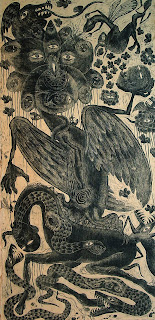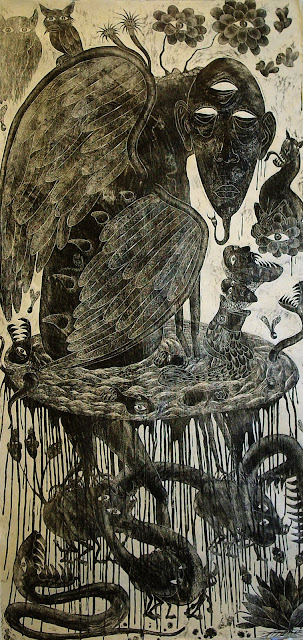In fact, our views of hell are typically not of a place but a space defined by the horrors occurring, though skewed perspective and disproportionate scale is an architectonic
feature. Moreover, a sense of descent is usually evident. Anthropomorphic and biomorphic forms move, turn and twist in terms of an urgent force of transformation.
The extremities of bodies grab, kick, embrace and resist frantically. Power is brutal and explicitly rendered in view of its opposite. Inversions occur: corporeal interiors become exterior; the end of life appears as the beginning of some form of existence; and perceptions of ‘low’ and ‘high’ are subverted. The hybrid as grotesque is pervasive, and the spectacular and sensational all-encompassing.
 |
|
|
 |
||
|
Like many artists in Thailand, Kriangkrai is influenced by Theravada Buddhism, where spiritual practice aims at breaking away from samsara or the endless cycles of life and death within the Thribumi. The artist cites Thribumi or Three Worlds: a cosmological and hierarchical worldview, dating from the Sukhothai period of Thailand in the 14th century, in which humans live in the midst of the Realm of Sensation. Vivid descriptions of deities, devils and hellish animals provide a rich source for Kriangkrai in terms of how these creatures are so creatively rendered and understood as effecting, as well as representing, the world we live in. Most importantly, they give shape to the analogous rather than the scientific.
Kriangkrai’s prints recall the diffuse compositions of cosmological maps. While hierarchies are operative, purported minor details prove just as compelling as a central focus. His works are aggressive engagements with unpalatable aspects of how we understand ourselves, from the casual to the profound. We ultimately learn to recognize that we are the source of the evil we often believe is Other.
 |
| Kriangkrai Kongkhanun,Spiritual Disease 7, Woodcut,200 x 100 cm,2009 |

You need to be a member of PORTFOLIOS*NET to add comments!
Join PORTFOLIOS*NET